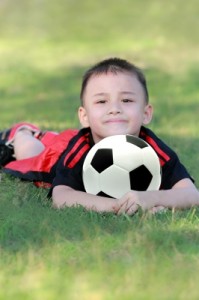The email from the AYSO Region 122 – Infection Control Committee started out innocently enough (aside from the eerie Soviet era name): “In an effort to promote good hygiene and prevent the spread of disease” the board of directors of our local youth soccer group had formed an Infection Control Committee.
Okay, fine. We have a hard time getting enough parents to volunteer to referee and coach, but if they wanted form a committee to promote good hygiene I’m okay with that.
The first few paragraphs advocated what is basically common sense: stay home if you are sick; if you have a fever or other symptoms stay away from other kids until you’ve been well for 24 hours; don’t share water bottles, etc.
Even the suggestion to use “an alcohol-based hand sanitizer before handing out snacks and after a game” (as opposed to washing your hands) was probably a good one, though I wondered if perhaps we were going to be seeing “sponsored by Purell” embroidered on next year’s uniforms.
Our school district superintendent sent out a similar letter, cautioning parents to teach children not to share their personal items, wash their hands and, mostly importantly, keep their sick kids at home. Hallelujah, this is a huge pet peeve of mine.
But there was one key difference between the two letters. AYSO asked us to avoid “pre and post game handshakes and/or high fives.” Followed by the caveat, “we can still promote good sportsmanship with a post game cheer and by respecting our opponents, coaches and referees.”
Seriously, no high fives? No handshakes?
While I realize that cleanliness is next to flu-lessness and can appreciate the good intentions behind this, I wondered if the Infection Control Committee realizes there is a fine line between healthy hygiene and obsessive germophobia. I’m all for keeping our kids healthy, but seriously, no high fives? That last bit of physical contact is more than just tradition. It’s an important sign of good sportsmanship, a visible symbol that we all played our hardest and, win or lose, we can walk away from the field feeling good about the game.
Seriously, no handshakes?
Sure enough, the ban on hand-to-hand contact was enforced after our game on Saturday, when the kids had just spent the last hour rolling around the grass together, chest bumping, wrestling and helping each other up when they fall down.
The kids didn’t know what to do. Were fist bumps okay? One adult suggested shoulder taps, which I was sure, would result in a brawl.
My response was to giggle at the absurdity of it all. I wasn’t the only one. A referee commented on how odd it was that the kids were forbidden to shake each other’s hands, but that didn’t stop them from all coming to politely shake his hand and thank him for officiating their games. “Next time I’m going to hand out wipes,” he joked.
“I suppose latex gloves are always an option, and how about face masks,” said another soccer mom.
“Oh puleeeeeese,” said another friend. “Might as well have your kids just stay home FOREVER!!!”
Some saw the move as an indication of more than just a flu scare. “Ridiculous,” said a dad. “It seems part of the increasing attempt to teach every child to be afraid of everyone and everything… all for the sake of protecting other entities from liability. Invest in some hand sanitizer if the need arises but let the hugging and high fives commence/continue.”
Another said, “Must have been a big disappointment to have to cancel the planned mandatory AYSO feel good group hug. If I was still coaching I’d name the team the Snot Rockets and dominate.”
When asked about the handshake issue, assistant commissioner Eric Sanborn responded, “Please picture what the average six year old looks like after a soccer game. Sweaty and dirty, with a ring of Gatorade, snot and little bits of orange and watermelon all around his mouth. His shirt and hands were used all game to wipe his nose and they are now all covered with “snail trails” of snot. Would you want to slap ten hands like that and then eat a snack and lick your fingers? Especially during this cold season?”
I’ll admit, that’s not a pretty picture.
“We discussed what other sports leagues, including some professional soccer leagues, have done to reduce the spread of germs in a sports setting and we determined that the after game handshake/high fives followed by postgame snacks, was the likely time for kids to share germs with their teammates and opponents,” Sanborn continued. “We decided to take the focus away from handshakes and high fives for this season only and try to promote good sportsmanship in other ways. It was amazing to see how well parents responded last weekend. … The feedback from our families has been overwhelmingly positive, with a ratio close to 20 positive emails for each complaint.”
Okay, I get it. I wouldn’t want to be the one who gives all the kids in Santa Barbara the swine flu either. No hard feelings. High five!

